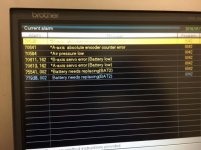A 10 mb should be plenty. I think there is a max on the B00 control, but don't remember if it is 8 or 16 gb. The files are all ascii files with most being around 2kb in size IIRC. Doesn't take much memory at all. These controls are Linux based, so files are pretty lean. If you have a 1gb stick from a trade show or something that would be enough for many backups.
The cable connectors for the rotaries should have been keyed for orientation. Depending on the set-up, it is most likely the Servo Amp for the tilt axis is a higher amperage (and physically bigger) than the one for the rotary axis. If you open the electrical cabinet, the 4/5 amps will be mounted below the other axis amps, to the right side in the control box. You can follow the cables from the amp to the plugs to help with hooking up the correct cable IF the cables still have a legible label (doubtful on a used machine, but possible).
As for the table and getting rid of the error....
Procedure:
1. Press I/O button
1a. (EDIT) I think you have to press I/O F key then the right arrow, I do it so often to change the write parameter that it is just habit and I can't remember)
2. Press right Arrow key
3. Press "Version"
4. Press "1" then <enter> (Parameter write enable)
5. Press 'I/O Menu" F key
(Takes you back to the very first menu screen of the I/O menu, should see a list of options for the F keys vertically on the screen)
6. Type -9999 and <enter>
7. Bottom right of the screen you will see "Reset Addt'l Axis" (next to last F key)
8. Press that F key
9. Cursor to the first box beside of "A" (or B) axis label depending on how the tilt/rotary is mounted
10. Press "2" <enter> (reset encoder counter)
WAIT until the 2 disappears
11. Move cursor back to that box and press "1" then <enter> (set axis display to 0)
Follow Steps 9-11 for "B" axis (or C axis, depending on how they are on the table)
Press <rst> key (reset)
Note: This just resets the encoders to wherever the table is currently at to be Zero. To properly set up the axis, you would of course tram in the A (or B - tilt) axis and reset the encoder again. - Same for the rotary. You can use the second box over from the A, B or C label to actually tell it a dimension to set the axis to when you do the 1 <enter> thing. i.e. if you tram the tilt axis in at -90° then you would enter -90.000 in the second box over before you did the 1 <enter> of the above procedure. You can also just do a 1 <enter> if you haven't changed motors/encoders and the encoder counts that are displayed match pretty closely.
Or just do as BrotherFrank said and call Yamazen and they can walk you through it at the control in just a couple of minutes.
BrotherFrank: Thanks for the correction I thought the other two were for the additional axis, now I know they are for the control only.




 Very cool machine...never run a Brother before....at least for manual functions more intuitive than Robodrills....I have yet to crack open a manual or call Yamazen and yet have all 5 axis homed, moving about, turret tool changing, rotating, spindle running to full RPM. Have to admit I just guessed at the A & B connections however....the Nikken homes and runs great...but still don't know if A is supposed to be rotary "table" axis or if B is !
Very cool machine...never run a Brother before....at least for manual functions more intuitive than Robodrills....I have yet to crack open a manual or call Yamazen and yet have all 5 axis homed, moving about, turret tool changing, rotating, spindle running to full RPM. Have to admit I just guessed at the A & B connections however....the Nikken homes and runs great...but still don't know if A is supposed to be rotary "table" axis or if B is !